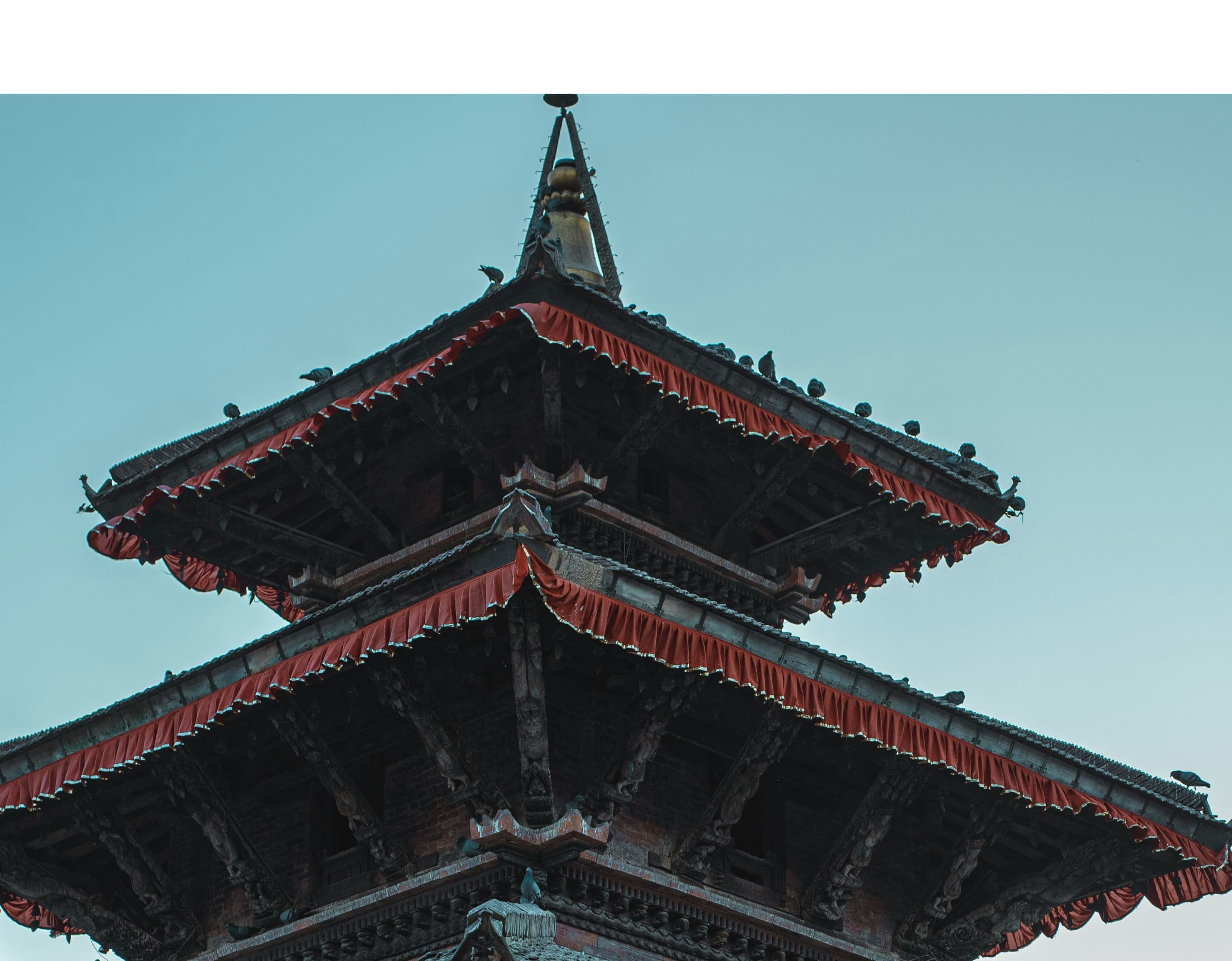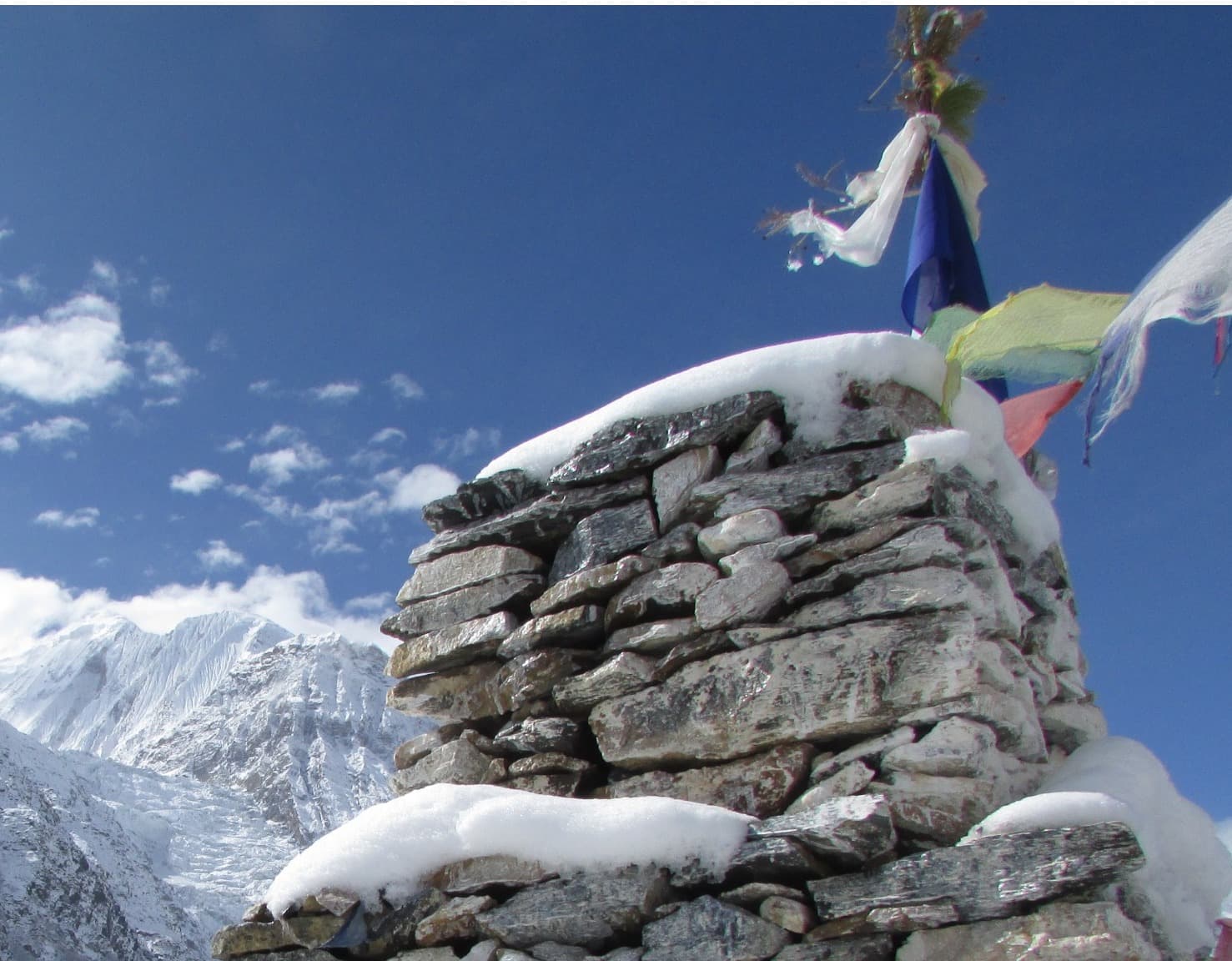Introduction To The Mountainous Gem
Bhutan, the mystical Himalayan kingdom, is home to some of the most spiritually rich and visually stunning destinations in the world. Among the top attractions in Bhutan, the Tiger’s Nest Monastery (Paro Taktsang) stands as the nation’s crown jewel—perched dramatically on a cliffside and accessed by a rewarding half-day hike. Another highlight is the Punakha Dzong, a masterpiece of Bhutanese architecture nestled between two rivers, offering spiritual serenity and historical depth. In Thimphu, the capital city, the majestic Buddha Dordenma overlooks the valley, attracting visitors with its grandeur and panoramic views. On the way to Punakha, travelers pass through Dochula Pass, famous for its 108 chortens and breathtaking Himalayan vistas. Paro Rinpung Dzong charms with its riverside location and traditional Bhutanese design, often featured during the Paro Tshechu festival.
For nature lovers, Phobjikha Valley (Gangtey) is a must-visit, especially in winter when black-necked cranes migrate to this pristine glacial valley. The National Memorial Chorten in Thimphu offers insight into Bhutan’s spiritual life, with locals circumambulating in prayer. Chele La Pass, the highest motorable road in Bhutan, rewards visitors with snow-capped peaks and access to the serene Kila Nunnery. In central Bhutan, the Bumthang Valley captivates with ancient temples, sacred sites, and peaceful countryside. Finally, Tashichho Dzong, home to the King’s office and the summer residence of Bhutan’s religious order, reflects the fusion of spirituality and governance.
These top tourist attractions in Bhutan make the kingdom a truly unique destination, ideal for cultural travelers, spiritual seekers, and Himalayan explorers looking for peace, purity, and unparalleled beauty.
.jpg)
Top Attraction of Bhutan
Bhutan, the Land of the Thunder Dragon, offers a blend of spiritual depth, Himalayan beauty, and cultural authenticity that few destinations can match. Among its top attractions, the legendary Tiger’s Nest Monastery (Paro Taktsang) tops every traveler’s list—a sacred cliffside temple that offers breathtaking views and a spiritual experience. In the valley of Punakha lies the magnificent Punakha Dzong, an architectural masterpiece set between two rivers, known for its historical and religious significance. Thimphu, Bhutan’s capital, houses the towering Buddha Dordenma, a colossal golden statue overlooking the valley. Travelers also marvel at the 108 chortens of Dochula Pass, which provides panoramic Himalayan views. The Phobjikha Valley is a tranquil nature escape, especially famous for sightings of the rare black-necked crane. Paro Rinpung Dzong, Tashichho Dzong, and National Memorial Chorten showcase Bhutan’s unique architecture and spiritual devotion. Scenic spots like Chele La Pass, the country’s highest motorable road, and the cultural richness of Bumthang Valley round out the top experiences. These top attractions reveal Bhutan as a destination of peace, purity, and deep-rooted tradition—ideal for travelers seeking more than just sightseeing. Whether through ancient monasteries, natural landscapes, or warm cultural encounters, Bhutan leaves a lasting impact on every visitor.
Tiger’s Nest Monastery (Paro Taktsang)
The Tiger’s Nest Monastery, or Paro Taktsang, is Bhutan’s most iconic spiritual site, dramatically perched on a cliff at 3,120 meters above the Paro Valley. This sacred Himalayan temple complex is a must-visit on any Bhutan travel itinerary, combining breathtaking natural beauty with deep religious significance. Accessible via a scenic hike, it offers panoramic views and a peaceful atmosphere that reflects Bhutan’s spiritual identity. It’s one of the most photographed and revered attractions in Bhutan, drawing thousands of pilgrims and travelers seeking both cultural insight and adventure.
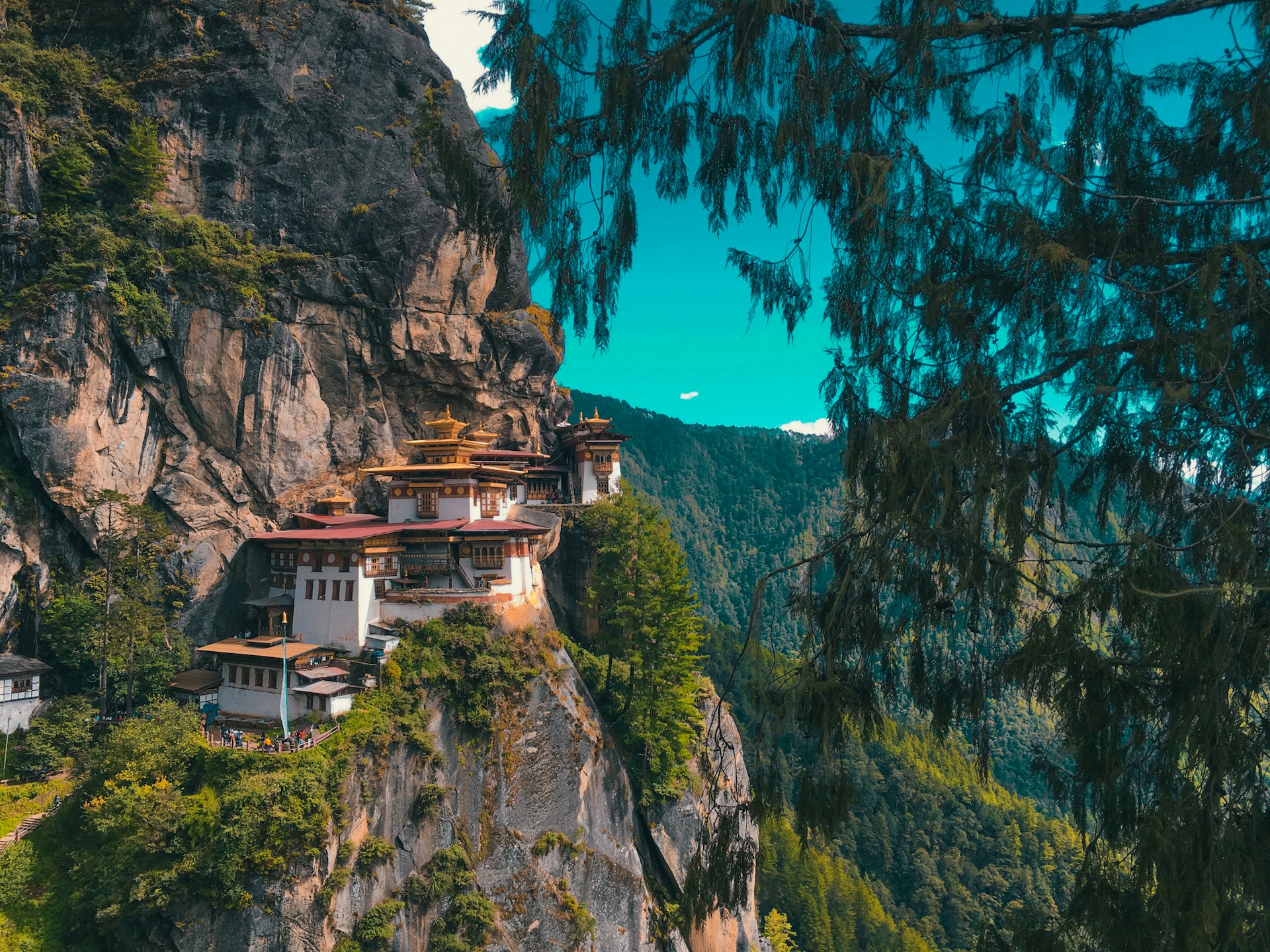
Cultural Significance of Tiger’s Nest Monastery
The Tiger’s Nest Monastery (Paro Taktsang) is one of the most sacred and culturally significant sites in Bhutan. Deeply rooted in Vajrayana Buddhism, it represents the spiritual identity of the Bhutanese people. The monastery is a revered pilgrimage site, drawing monks, devotees, and spiritual seekers who often make the steep climb to meditate in the caves and temples surrounding the cliffs. Its remote and awe-inspiring location is symbolic of Bhutan’s deep connection with the divine and the natural world. The monastery’s architecture, which clings seamlessly to the vertical cliff face, is a stunning representation of Bhutan’s traditional design that respects harmony with nature. Intricately carved wooden balconies, sacred murals, fluttering prayer flags, and butter lamps make the site not only visually enchanting but spiritually profound. For Bhutanese, visiting Tiger’s Nest is not just a journey—it is a spiritual rite of passage, an expression of devotion and humility before the sacred forces that protect and guide the country.
Historical Background of Tiger’s Nest
The Tiger’s Nest Monastery was built in 1692 by Gyalse Tenzin Rabgye, the fourth Druk Desi of Bhutan, at the site of a sacred cave. The legend behind its origin dates back to the 8th century, when Guru Padmasambhava (Guru Rinpoche)—credited with bringing Buddhism to Bhutan—flew to the cliffside cave on the back of a tigress to subdue a local demon. There, he meditated for three months and sanctified the site. This miraculous event gave the monastery its name, Paro Taktsang, meaning “Tiger’s Nest.” The site soon became a place of great religious importance, believed to be one of the thirteen “Tiger’s Lairs” where Guru Rinpoche meditated. Over centuries, it has remained a spiritual beacon for Buddhist practitioners across the Himalayan region. Though it suffered damage from fire in 1998, the monastery was meticulously restored to preserve its historical and spiritual essence. Today, Tiger’s Nest not only preserves the memory of Bhutan’s sacred origins but also stands as a testament to the nation’s dedication to preserving its spiritual heritage for future generations.
Importance in Bhutan Travel
Tiger’s Nest Monastery is undoubtedly the most iconic travel destination in Bhutan, frequently topping lists of must-see places in Asia and the Himalayas. For tourists, it offers a spiritual trekking experience that is both physically rewarding and emotionally uplifting. The 2-3 hour hike through pine forests, prayer wheels, and cliffside paths leads to one of the world’s most photogenic and revered monasteries. Travelers from around the globe come to Bhutan specifically to witness this wonder. Whether it's for spiritual reasons, adventure, photography, or cultural exploration, visiting Paro Taktsang is a highlight of any Bhutan itinerary. It symbolizes everything the country stands for: spirituality, serenity, sustainability, and sacredness. For many, the trek is more than a sightseeing activity—it’s a pilgrimage, a moment of introspection, and a personal achievement. Nearly all Bhutan tour packages, from 3-star cultural trips to luxury wellness retreats, include Tiger’s Nest as a centerpiece, making it an essential part of the Bhutan travel experience.
Punakha Dzong
Punakha Dzong, also known as Pungthang Dechen Phodrang (“Palace of Great Bliss”), is one of the most majestic and significant dzongs (fortresses) in Bhutan. Located at the confluence of the Pho Chhu (Male River) and Mo Chhu (Female River), the dzong is an architectural marvel and spiritual centerpiece in Bhutanese history. Surrounded by jacaranda trees that bloom in spring and guarded by rivers on both sides, Punakha Dzong presents a scene of divine tranquility and timeless beauty. It served as the capital of Bhutan until 1955 and remains the winter residence of the central monastic body and the Je Khenpo (Chief Abbot). The fortress is home to sacred relics and the embalmed body of Shabdrung Ngawang Namgyal, the founder of Bhutan. Its grand whitewashed walls, red-topped towers, elaborately painted wooden windows, and rich courtyards captivate every visitor. The dzong also hosts the famous Punakha Drubchen and Tshechu festivals, drawing locals and tourists alike. Whether viewed from a distance across the river or explored from within, Punakha Dzong offers a captivating blend of spirituality, architecture, and Bhutanese heritage, making it an essential stop on every Bhutan tour itinerary.
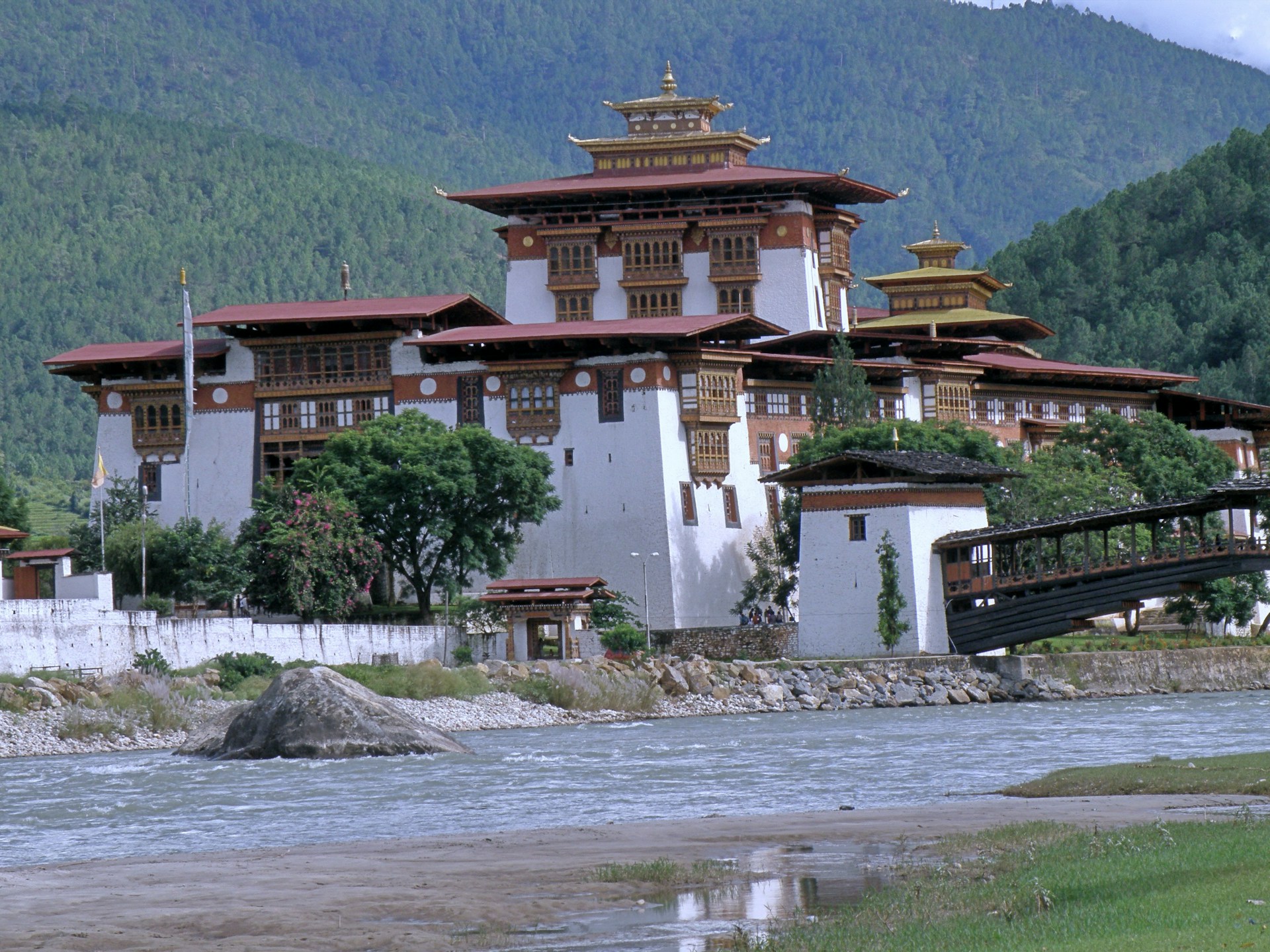
Cultural Significance of Punakha Dzong
Punakha Dzong holds immense cultural and religious significance in Bhutan. It is considered one of the most sacred and historically important dzongs, serving as the spiritual heart of the Punakha Valley. The dzong symbolizes the union of religion and governance—a concept deeply embedded in Bhutanese identity. It is the winter residence of the Je Khenpo (Chief Abbot) and the monastic body, who migrate here annually from Thimphu to escape the cold. This seasonal movement reinforces Punakha's cultural rhythm and importance. Architecturally, the dzong is a masterpiece of traditional Bhutanese craftsmanship, featuring intricate woodwork, whitewashed stone walls, and golden pinnacles. Within its sacred halls are statues, thangkas, and religious relics that play central roles in Bhutanese Buddhist rituals. The dzong also serves as the ceremonial site for royal events, including the wedding of King Jigme Khesar Namgyel Wangchuck in 2011. Its connection to Bhutanese monarchy, monasticism, and daily life makes it a living symbol of national unity and heritage. During festivals like Punakha Drubchen, locals re-enact historical battles to honor Bhutan’s spiritual guardians. For Bhutanese people, Punakha Dzong is not just a religious building—it's a sacred embodiment of their cultural identity, spiritual resilience, and national pride.
Historical Background of Punakha Dzong
Punakha Dzong was built in 1637–38 by Zhabdrung Ngawang Namgyal, the unifier of Bhutan, making it the second oldest and second largest dzong in the country. It was strategically constructed at the meeting point of the Pho Chhu and Mo Chhu rivers, symbolizing harmony between male and female energies. This location was chosen based on a prophecy and is revered as deeply auspicious. Over the centuries, the dzong has played a pivotal role in Bhutanese history. It served as the administrative center and capital of Bhutan until 1955, hosting important political and religious activities. It is also the site where the first King of Bhutan, Ugyen Wangchuck, was crowned in 1907, marking the beginning of the Wangchuck dynasty. Despite suffering from fires, floods, and an earthquake, Punakha Dzong has been meticulously restored each time, preserving its original grandeur. It houses some of Bhutan’s most sacred relics, including the Ranjung Kharsapani, a self-created image of Avalokiteshvara, and the embalmed remains of Zhabdrung himself. The dzong is a symbol of Bhutanese resilience, unification, and spiritual guardianship. Its historical legacy continues to influence the nation, as it remains one of the most important religious and cultural centers in Bhutan.
Importance of Punakha Dzong in Bhutan Travel
Punakha Dzong is one of the most essential landmarks for travelers visiting Bhutan, offering a perfect blend of history, culture, and architectural grandeur. Most Bhutan tour packages, from 3-star to luxury 5-star itineraries, include Punakha Dzong as a must-visit destination. Nestled between two rivers and surrounded by rice fields and mountains, the dzong offers an idyllic setting for photography, spiritual exploration, and cultural immersion. Visitors can walk across the iconic wooden cantilever bridge, marvel at the intricate carvings and murals, and witness monks performing daily rituals in the serene courtyards. During spring, the blooming jacaranda trees add a surreal purple hue, making it one of the most picturesque sites in Bhutan. For many, visiting Punakha Dzong provides a deeper connection to Bhutan’s peaceful way of life, traditional beliefs, and natural harmony. It’s also a popular site for hosting important religious and public events, including wedding blessings, prayer ceremonies, and tshechus (festivals). Whether you are on a short 4-day cultural tour or an extended 8-day exploration, Punakha Dzong stands out as a highlight—offering insight into Bhutan’s past, inspiration for the present, and serenity for the soul. It truly encapsulates the essence of Bhutanese heritage and spirituality.
Tashichho Dzong (Thimphu)
Tashichho Dzong, located on the western bank of the Wang Chhu River in Thimphu, is one of Bhutan’s most majestic and politically significant landmarks. Known as the “Fortress of the Glorious Religion,” it serves as the seat of the Bhutanese government, housing the King’s office, key ministries, and the summer residence of the Je Khenpo (Chief Abbot). With its striking white walls, red-golden towers, and manicured lawns, the dzong exudes both authority and elegance. Originally built in the 13th century and later expanded by Zhabdrung Ngawang Namgyal in 1641, it has been rebuilt and refined multiple times, most recently in the 1960s when Thimphu became Bhutan’s capital. Visitors are often awed by its architecture—a fine example of traditional Bhutanese design with courtyards, temples, and assembly halls. The dzong also hosts the vibrant Thimphu Tshechu, one of the largest religious festivals in Bhutan, attracting locals and tourists alike. Open to visitors after office hours and on weekends, Tashichho Dzong is not just a political hub but a powerful symbol of Bhutan’s unity of religion and governance. It’s a must-see destination on any Bhutan tour and offers deep insight into the country’s spiritual-political harmony.
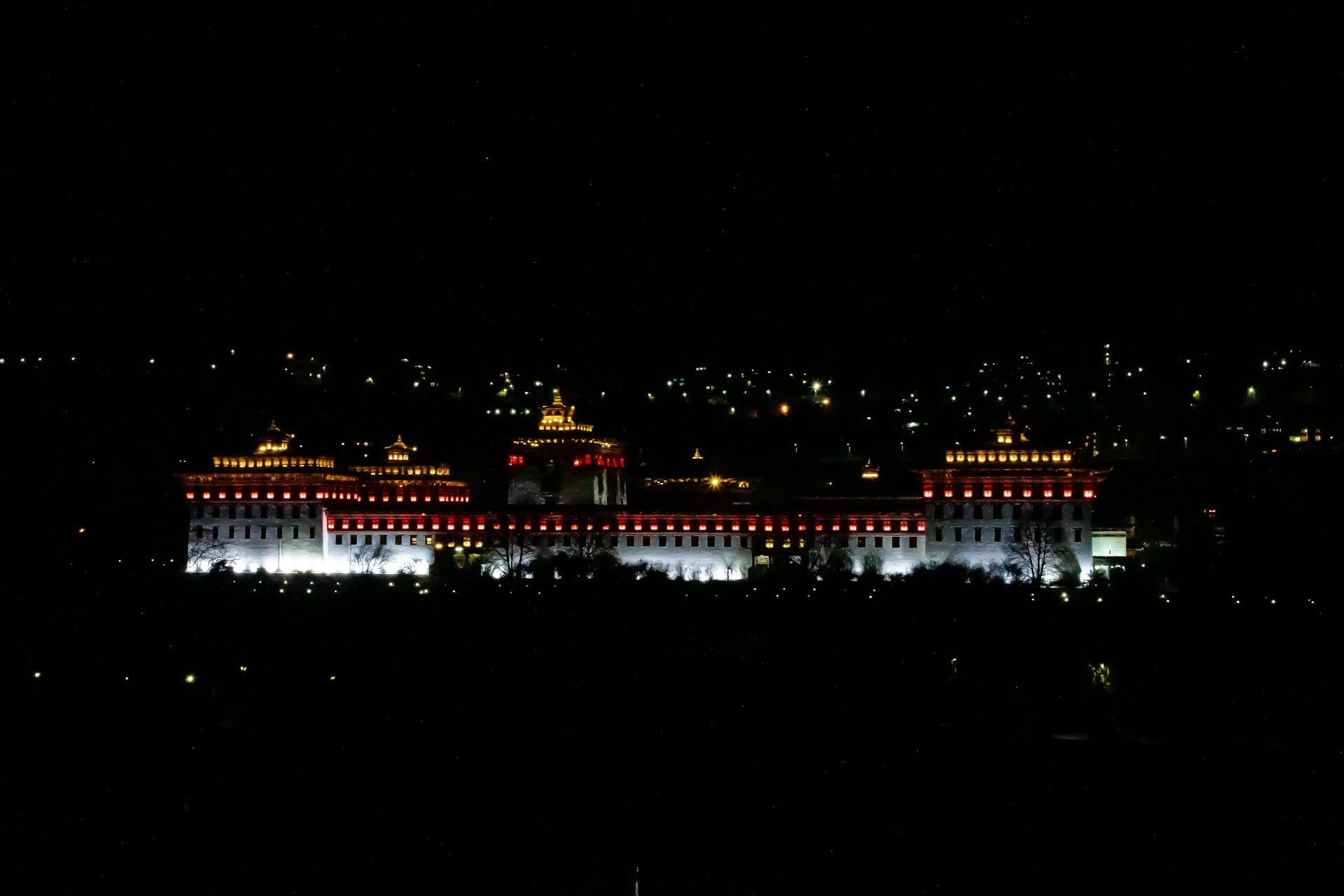
Cultural Significance of Tashichho Dzong
Tashichho Dzong holds a unique position in Bhutanese culture as both a spiritual sanctuary and a symbol of national governance. Unlike other dzongs that primarily serve monastic functions, Tashichho Dzong is the official residence of the King of Bhutan and the summer home of the central monastic body, led by the Je Khenpo. This dual function highlights the inseparable relationship between religion and state in Bhutanese culture. The dzong’s design—featuring prayer halls, temples, and government offices in the same complex—symbolizes the country’s commitment to harmony between the spiritual and secular realms. The central utse (tower), traditional wooden windows, and golden rooftops reflect Bhutanese aesthetics and religious devotion. The dzong is also the venue for important national ceremonies, such as the King’s coronation and state receptions. Culturally, it serves as a gathering point for the annual Thimphu Tshechu, a festival filled with mask dances and religious blessings. These events bring together monks, locals, and tourists, creating a vibrant cultural atmosphere rooted in tradition and faith. As a representation of Bhutan’s identity, Tashichho Dzong remains one of the most important landmarks showcasing the country’s cultural unity, spiritual values, and royal heritage.
Historical Background of Tashichho Dzong
The origins of Tashichho Dzong date back to the 13th century, when it was first built by Lama Gyalwa Lhanangpa and named Do Ngon Dzong (Blue Stone Fortress). In 1641, Zhabdrung Ngawang Namgyal, the unifier of Bhutan, took over and rebuilt the structure, renaming it Tashichho Dzong. The dzong was moved and reconstructed several times due to natural disasters, including fire and earthquake damage. Its current form was established in the 1960s under the leadership of the third King, Jigme Dorji Wangchuck, when Thimphu was declared the new capital of Bhutan. Unlike many other dzongs that focus primarily on religious use, Tashichho Dzong was intentionally designed to function as both a religious and administrative center—making it one of the most unique dzongs in the country. It houses key government ministries such as Home Affairs and Finance, alongside sacred temples and shrines. The throne room and King’s secretariat are also located within the complex. Despite its political role, the dzong retains deep spiritual significance and has long been associated with national unity and strength. Its layered history and role in Bhutanese statehood make it a living monument that blends monastic traditions, royal power, and Bhutanese resilience.
Importance of Tashichho Dzong in Bhutan Travel
For travelers visiting Bhutan, Tashichho Dzong is a key attraction in the capital city, offering a unique glimpse into Bhutan’s political structure, religious practice, and architectural heritage. Most Bhutan tour packages—from cultural 4-day trips to in-depth 8-day explorations—include a guided visit to this impressive site. While the dzong functions as a government office during the day, it opens to tourists in the late afternoon and on weekends, providing a chance to explore its outer courtyards, gardens, and temples. The dzong is especially mesmerizing during the annual Thimphu Tshechu Festival, when locals gather in traditional dress to witness vibrant mask dances and spiritual rituals in its grand courtyard. The backdrop of rolling hills, the Wang Chhu River, and the dzong’s massive white walls make it a top spot for photography and cultural reflection. Travelers interested in Bhutanese governance can appreciate the blending of secular administration with sacred spaces. For those seeking spirituality, the presence of monks and temples within the same space offers a peaceful, meditative atmosphere. Whether you’re drawn to Bhutan’s spiritual heritage, architecture, or royal history, Tashichho Dzong is an essential stop, perfectly representing the harmonious balance of tradition and progress in Bhutan.
Dochula Pass
Dochula Pass is one of Bhutan’s most scenic and spiritually significant mountain passes, located at an altitude of 3,100 meters on the way from Thimphu to Punakha. It is best known for the stunning array of 108 chortens (stupas) known as the Druk Wangyal Chortens, built in honor of Bhutanese soldiers who lost their lives in a 2003 military operation. On a clear day, Dochula offers breathtaking panoramic views of the Eastern Himalayas, including peaks like Masang Gang, Gangkar Puensum, and Jichu Drake. The pass is also home to the Druk Wangyal Lhakhang, a unique temple that showcases modern Bhutanese art and celebrates the monarchy. Blanketed in mist or blooming with rhododendrons in spring, Dochula Pass is a place of reflection, remembrance, and natural beauty. It's a must-stop point for most Bhutan tours, perfect for short breaks, photo opportunities, and quiet moments amidst fluttering prayer flags and mountain silence.
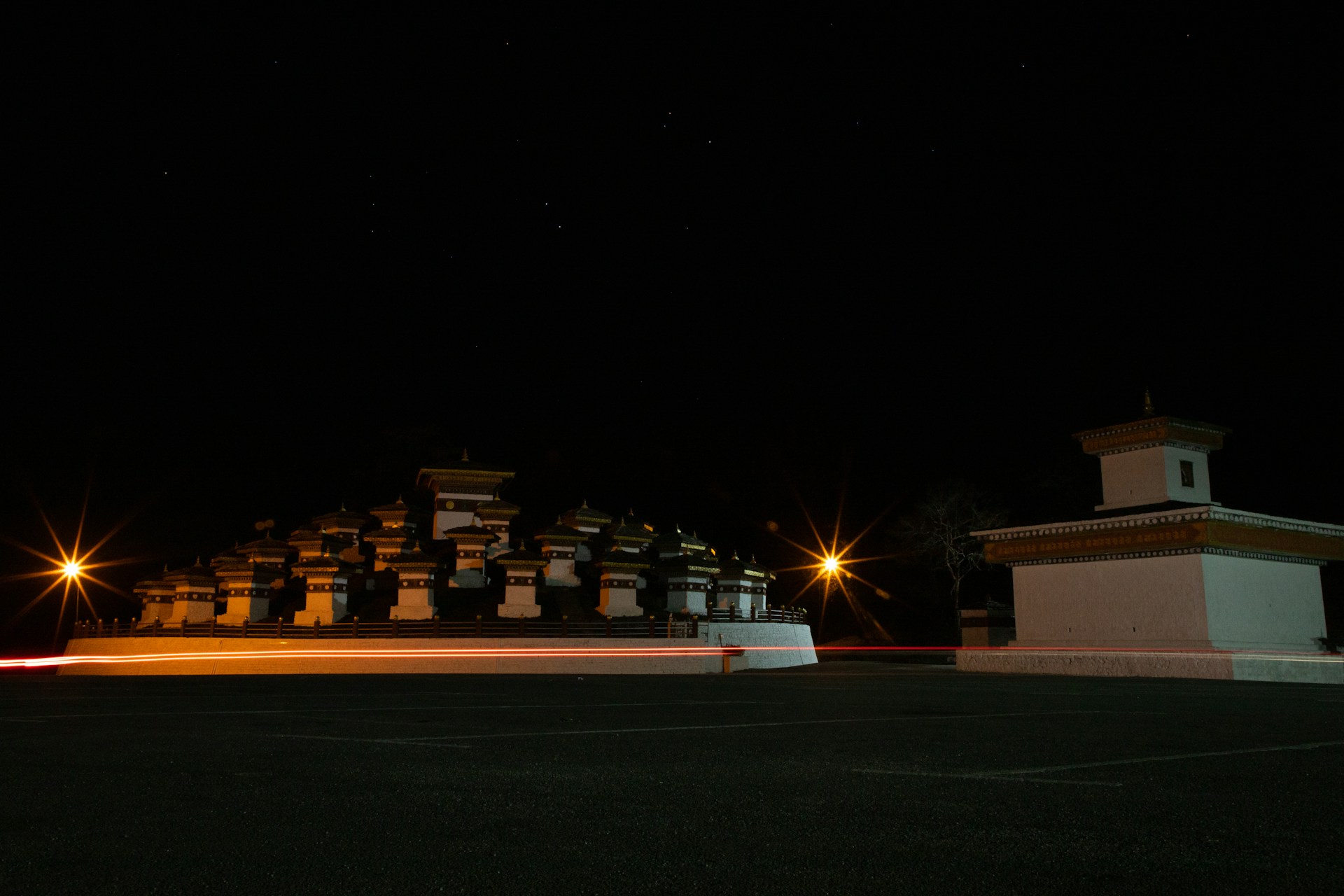
Cultural Significance of Dochula Pass
Dochula Pass is not only a scenic highlight but also a deeply spiritual landmark in Bhutan. The 108 chortens, known as Druk Wangyal Chortens, were commissioned by Queen Mother Ashi Dorji Wangmo Wangchuck to commemorate the valor of Bhutanese soldiers. Each chorten is a symbol of peace, harmony, and spiritual protection. Lined with prayer flags, the pass creates an atmosphere of calm and reverence, attracting both locals and visitors. Bhutanese travelers often stop here to offer prayers before continuing their journey. The nearby Druk Wangyal Temple reflects Bhutan’s evolving spiritual art, blending traditional Buddhist iconography with contemporary storytelling. The entire site highlights Bhutan’s commitment to honoring its spiritual roots while recognizing modern history. For Bhutanese people, Dochula is a site of national pride and spiritual symbolism, uniting memory, mindfulness, and mountain majesty.
Historical Background of Dochula Pass
The significance of Dochula Pass grew in 2003 after a military conflict against insurgents hiding in southern Bhutan. In remembrance of the soldiers who lost their lives, the Queen Mother built 108 chortens, forming what is now known as the Druk Wangyal Chortens. While passes in Bhutan have always been used as spiritual and geographic markers, Dochula took on a nationalistic and commemorative identity with these structures. In 2008, the Druk Wangyal Lhakhang (temple) was added to honor the fourth king, His Majesty Jigme Singye Wangchuck, who led the operation. The temple’s murals uniquely portray both religious deities and modern Bhutanese achievements, including the military operation itself. Since then, Dochula has become a symbolic place of remembrance, blending tradition with contemporary Bhutanese pride. Its story is a reminder of Bhutan’s strength, unity, and peaceful approach to sovereignty—told not through weapons but through chortens, art, and prayer.
Importance of Dochula Pass in Bhutan Travel
Dochula Pass is a staple on nearly every Bhutan tour itinerary, especially for those traveling between Thimphu and Punakha. It’s often the first high-altitude stop for travelers, offering them stunning 360-degree views of snow-capped peaks when skies are clear. Springtime rewards visitors with vibrant rhododendron forests, while winter brings an ethereal, misty charm. For photographers and nature lovers, Dochula is a dream. The 108 chortens and colorful prayer flags also make it one of the most photographed landmarks in Bhutan. Cultural travelers appreciate the symbolism behind the monuments, while spiritual seekers often spend quiet moments in prayer. The Druk Wangyal Festival, occasionally held here, showcases mask dances and celebrates Bhutanese heritage. Whether part of a short 4-day Bhutan tour or a week-long journey, Dochula is a peaceful, photogenic, and meaningful stop that perfectly embodies Bhutan’s blend of nature, culture, and spirituality.
Phobjikha Valley
Phobjikha Valley is a wide, glacial valley located in Wangdue Phodrang District of central Bhutan, near the famous Gangtey Monastery. Surrounded by black mountains and blanketed in alpine meadows, it’s one of Bhutan’s most scenic and serene destinations. The valley is also the winter home of the rare and endangered black-necked cranes, which arrive from Tibet between late October and February. With its pristine environment, absence of urban development, and strong conservation efforts, Phobjikha is a model for eco-tourism in Bhutan. The peaceful landscapes, village walks, and spiritual energy make it a perfect retreat for nature lovers and cultural travelers alike.

Cultural Significance of Phobjikha Valley
Phobjikha Valley is deeply connected to Bhutanese spirituality and conservation values. The valley surrounds the sacred Gangtey (Gantey) Monastery, home to the Peling Buddhist tradition and one of the most important religious institutions in Bhutan. Every year, locals and monks celebrate the arrival of the black-necked cranes, believed to be spiritual messengers. These birds are so revered that they are celebrated through the Black-Necked Crane Festival held in November. The harmonious coexistence of humans, wildlife, and monks in this remote valley reflects Bhutan’s unique balance between spiritual life and environmental stewardship, making it culturally rich and spiritually uplifting.
Historical Background of Phobjikha Valley
Historically, Phobjikha Valley has been closely associated with the Gangtey Monastery, which was founded in the 17th century by Gyalse Pema Thinley, the grandson of Bhutan’s great spiritual leader Pema Lingpa. The monastery played a central role in the religious life of the region, guiding the local communities in faith and festivals. The valley remained largely untouched for centuries due to its remoteness. It was only in recent decades that the area gained recognition as a protected conservation zone, primarily for the black-necked cranes. Efforts to preserve both the natural and cultural heritage have made Phobjikha a symbol of Bhutanese tradition and sustainability.
Importance of Phobjikha Valley in Bhutan Travel
Phobjikha Valley is a highlight in central Bhutan tour itineraries, particularly for those seeking eco-friendly, off-the-beaten-path experiences. It offers stunning nature walks, traditional farm stays, and a chance to observe the black-necked cranes in their natural habitat. The Gangtey Nature Trail is a favorite among travelers for its scenic views and village encounters. Visitors also get to witness Bhutanese rural life, interact with locals, and experience authentic hospitality. For those interested in slow travel, photography, and conservation, Phobjikha offers a unique and peaceful escape. It is a must-visit destination for those wanting to feel Bhutan’s untouched natural and cultural charm.
Bumthang Valley
Bumthang Valley, often referred to as the spiritual heartland of Bhutan, lies in central Bhutan and is home to some of the country’s most ancient and revered temples and monasteries. It comprises four main valleys—Choekhor, Tang, Ura, and Chhume—each rich in culture, nature, and history. Surrounded by forested hills and dotted with monasteries, Bumthang offers a tranquil atmosphere ideal for spiritual retreats and cultural exploration. The valley is also known for traditional wool weaving (Yathra) and rural lifestyles. With its mystical charm and heritage, Bumthang is a highlight for those seeking deeper spiritual and cultural experiences in Bhutan.
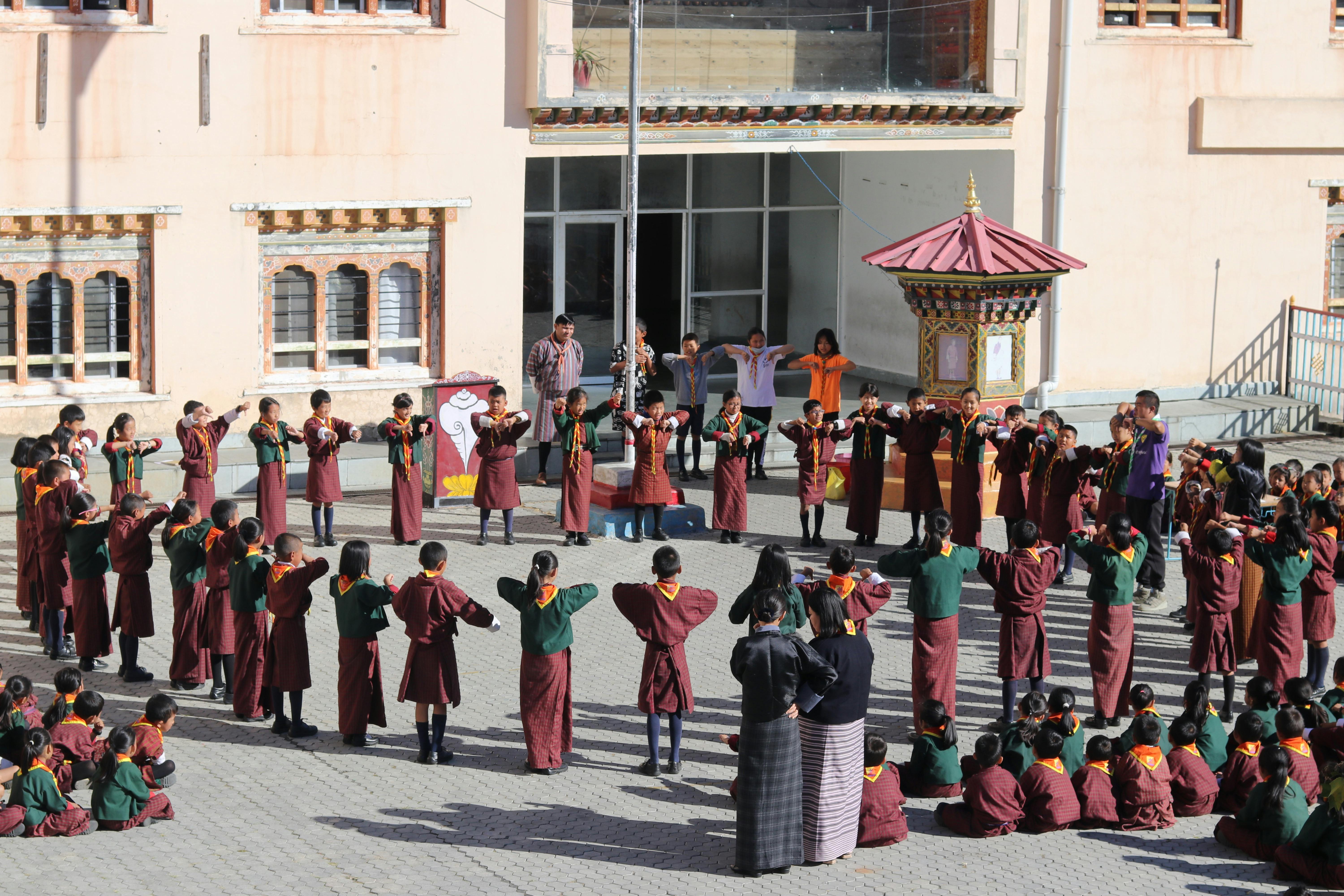
Cultural Significance of Bumthang
Bumthang holds deep spiritual importance in Bhutanese Buddhism, housing some of the country’s oldest monasteries and temples, such as Jambay Lhakhang, Kurjey Lhakhang, and Tamshing Monastery. Many of these sites are linked to Guru Rinpoche (Padmasambhava) and the revered treasure-revealer Pema Lingpa. Monks and pilgrims travel from across Bhutan to meditate, offer prayers, and receive blessings here. Local festivals like Jambay Lhakhang Drup showcase sacred dances and fire rituals. The valley’s peaceful ambiance, prayer flags, and chortens reflect Bhutan’s enduring devotion. Bumthang is not just a destination—it’s a living, breathing center of faith, tradition, and spiritual awakening.
Historical Background of Bumthang
Bumthang’s history is closely tied to the introduction and spread of Buddhism in Bhutan, particularly in the 8th century when Guru Rinpoche is said to have meditated at Kurjey Lhakhang, leaving his body imprint in a sacred cave. Over centuries, many great lamas, including Pema Lingpa, a famous Bhutanese saint, established temples and spiritual schools here. The region became a cultural and religious hub, influencing Bhutan’s spiritual evolution. With royal patronage and strong local devotion, Bumthang flourished as a center of pilgrimage and learning. Today, it retains its ancient charm, with monasteries that preserve centuries-old art, scriptures, relics, and living traditions.
Importance of Bumthang Valley in Bhutan Travel
Bumthang is a must-visit destination for cultural and spiritual travelers in Bhutan. While it requires a longer journey to reach—either by domestic flight or scenic drive—it rewards visitors with deep cultural immersion, peaceful landscapes, and authentic Bhutanese experiences. Most Bhutan tour packages that span 7–10 days include Bumthang, especially for those exploring Bhutan in depth. The valley offers unique experiences such as visiting ancient temples, attending local festivals, hiking between villages, and tasting local cheese, honey, and red rice. Whether you're on a spiritual journey or a cultural exploration, Bumthang Valley provides insight into Bhutan’s sacred roots and timeless way of life.
Chele la Pass
Chele La Pass is the highest motorable road in Bhutan, sitting at an altitude of 3,988 meters (13,083 feet), located between Paro and Haa Valley. It offers breathtaking views of the Himalayas, including Mount Jomolhari and Mount Jichu Drake on clear days. Surrounded by prayer flags, pine forests, and alpine meadows, it's a serene and photogenic spot. Chele La is often visited as a half-day excursion from Paro and is ideal for short hikes, picnics, and panoramic photography. It’s a peaceful escape into nature, offering travelers a tranquil contrast to Bhutan’s cultural attractions.
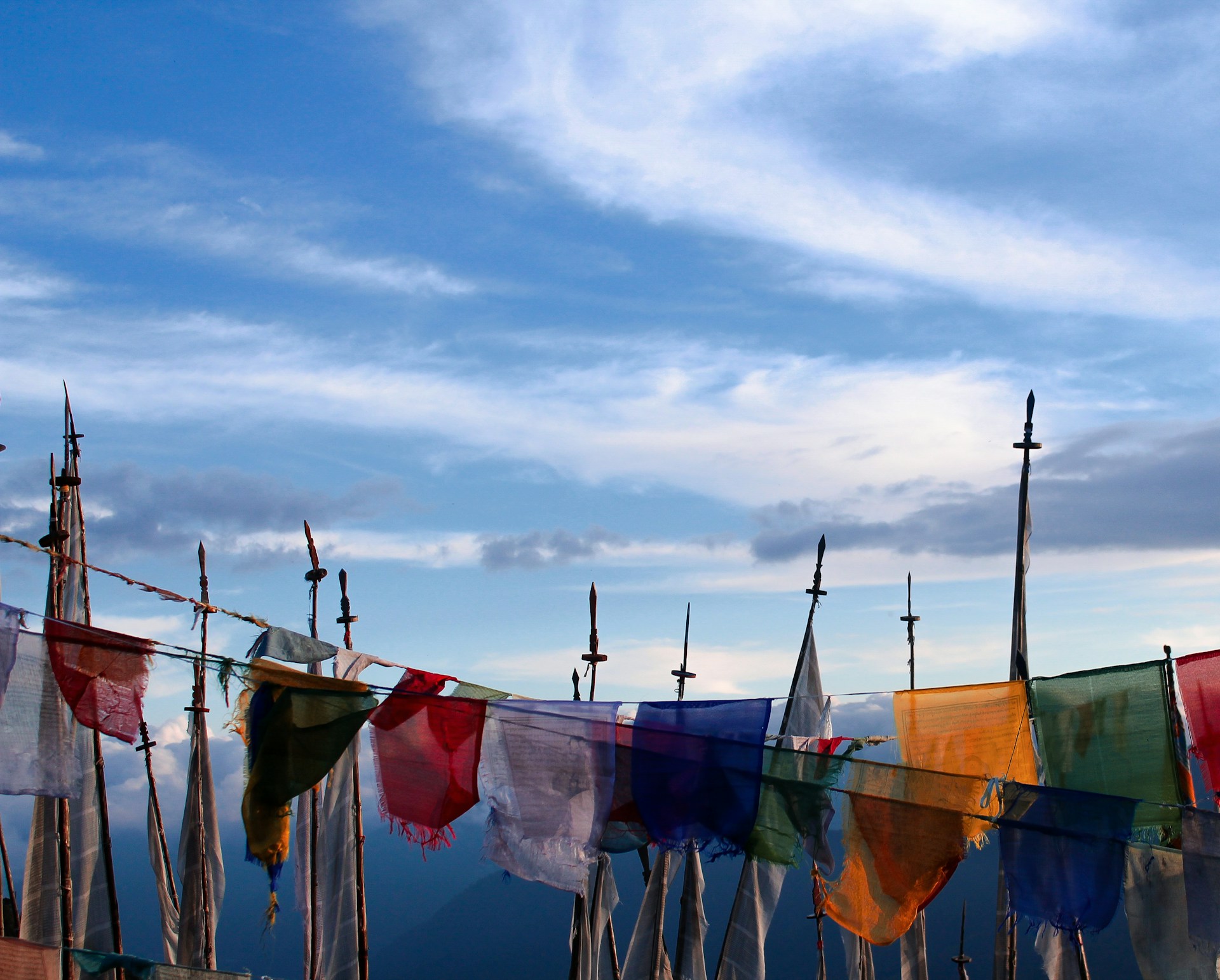
Cultural Significance of Chele La Pass
Chele La Pass is adorned with hundreds of colorful prayer flags, placed by locals and pilgrims to bless the wind and spread goodwill. The pass serves as a spiritual site where people stop to offer prayers and reflect on nature’s beauty. It also holds religious significance due to its proximity to the Kila Nunnery, one of Bhutan’s oldest nunneries, nestled on a cliff below the pass. Visiting Chele La offers travelers a glimpse into Bhutanese spiritual practice outside temples, emphasizing nature, wind, and mountain energy as sacred forces.
Historical Background of Chele La Pass
Though Chele La is primarily known for its natural beauty, it has long been a connecting route between Paro and the secluded Haa Valley. Traditionally, it was used by traders, monks, and pilgrims making their way between districts. The area surrounding the pass has also been used for pastoral grazing and forest gathering by local villagers. The development of the road has made it more accessible in recent decades, but its spiritual ambiance and remote charm remain unchanged, making it both a historic and scenic highland crossing.
Importance of Chele La Pass in Bhutan Travel
Chele La Pass is a top natural attraction for travelers seeking scenic vistas and high-altitude Himalayan experiences. Most Paro-based Bhutan tour packages include a drive to Chele La as a day trip. It’s a favorite spot for photography, meditation, and birdwatching. On a clear day, the views of snow-capped peaks and deep valleys are unforgettable. Visitors often combine it with a short hike or a visit to the Kila Goenpa Nunnery. For nature lovers and casual trekkers, Chele La adds an adventurous, refreshing highlight to any Bhutan tour.
Buddha Dordenma
The Buddha Dordenma is a colossal golden statue of Shakyamuni Buddha, seated atop a hill overlooking Thimphu Valley. Standing at 51.5 meters (169 feet) tall, it is one of the largest Buddha statues in the world, made of bronze and gilded in gold. The statue houses over 125,000 smaller Buddhas inside its body and base. It’s visible from almost every part of Thimphu and offers sweeping views of the city and surrounding mountains. A popular tourist stop, the site combines religious significance with modern grandeur, symbolizing Bhutan’s spiritual devotion and national unity.
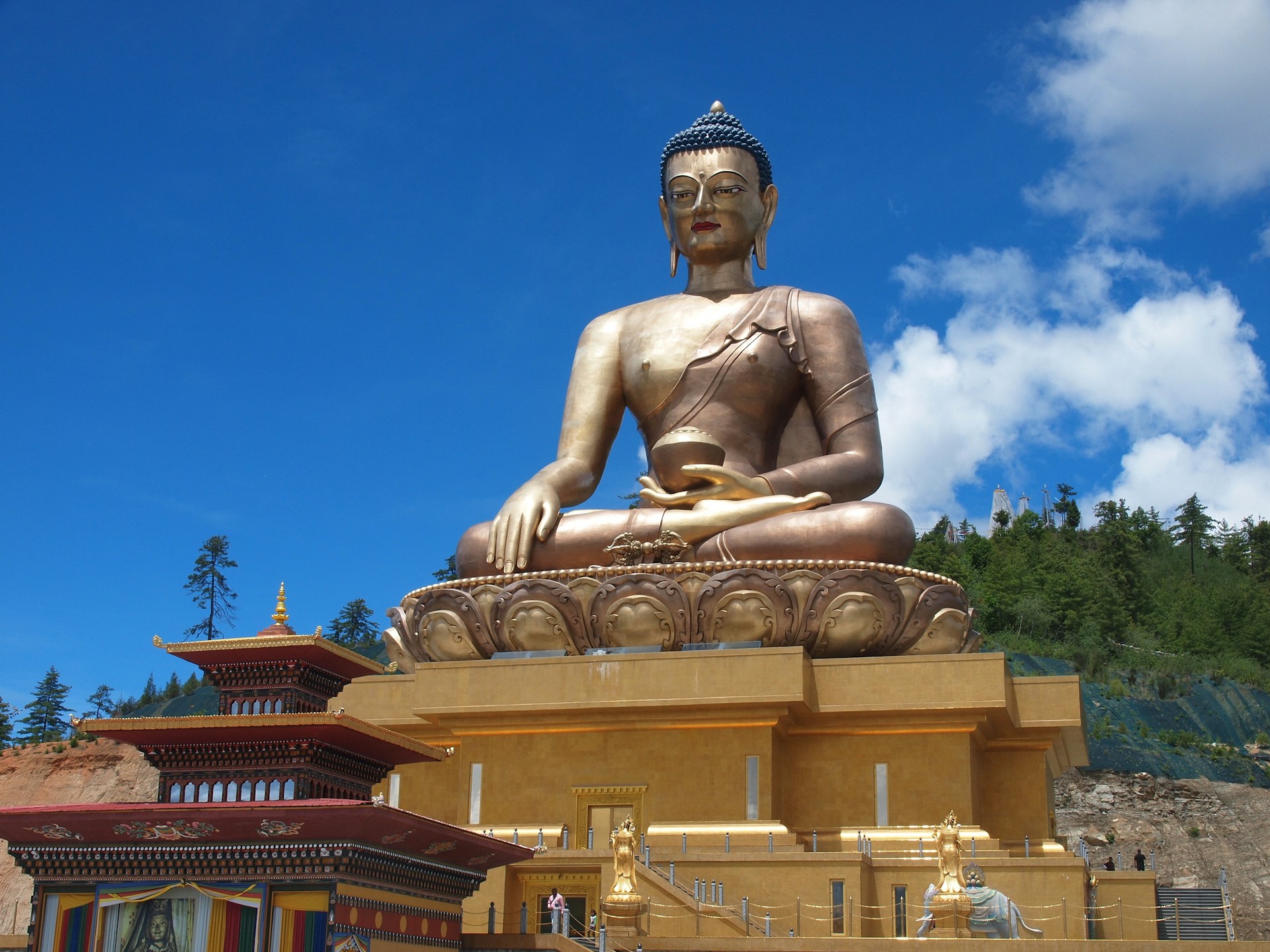
Cultural Significance of Buddha Dordenma
Buddha Dordenma represents Bhutan’s faith in Vajrayana Buddhism and its commitment to global peace and happiness. The statue was built to fulfill an ancient prophecy that foretold the construction of a large Buddha to bring peace and prosperity to the region. Surrounded by meditation halls, prayer wheels, and monastic buildings, the site serves as a pilgrimage destination for Bhutanese and Buddhist devotees. It reflects the nation’s cultural identity—blending modern craftsmanship with timeless spiritual values—making it a sacred symbol of Bhutan’s reverence for compassion, wisdom, and national pride.
Historical Background of Buddha Dordenma
The idea for Buddha Dordenma originates from an ancient terma (hidden prophecy) revealed by Terton Pema Lingpa, foretelling the construction of a giant Buddha statue in the region. Construction began in 2006 and was completed in 2015, marking the 60th birth anniversary of the Fourth King, Jigme Singye Wangchuck. The statue was built with funding from both the Bhutanese government and international patrons, showcasing Bhutan’s dedication to spiritual progress. Its placement overlooking Thimphu reflects the blending of ancient prophecy and modern nationhood, making it both a religious and national landmark.
Importance of Buddha Dordenma in Bhutan Travel
Buddha Dordenma is one of the top tourist attractions in Thimphu and a key highlight in nearly all Bhutan tour itineraries, from short cultural trips to luxury wellness tours. The site offers not only religious importance but also panoramic views of Thimphu Valley, making it a favorite for photographers and spiritual travelers alike. Visitors can stroll through the surrounding Kuenselphodrang Nature Park, spin prayer wheels, or sit in meditation at the foot of the statue. It’s a serene and monumental place that encapsulates the essence of modern Bhutanese spirituality and royal vision.
Bhutanese farmhouses
Bhutanese farmhouses are traditional, multi-story homes found in rural villages across Bhutan, particularly in regions like Paro, Bumthang, and Haa Valley. Built using stone, timber, and mud without nails, these colorful structures reflect Bhutanese architectural beauty. Visitors often get the opportunity to dine, bathe, or stay overnight in a farmhouse as part of cultural tour experiences. With warm hospitality, local food, and a peaceful environment, farmhouses offer an authentic window into Bhutan’s rural lifestyle. Surrounded by terraced fields and mountains, they provide a genuine and immersive alternative to conventional hotel stays.
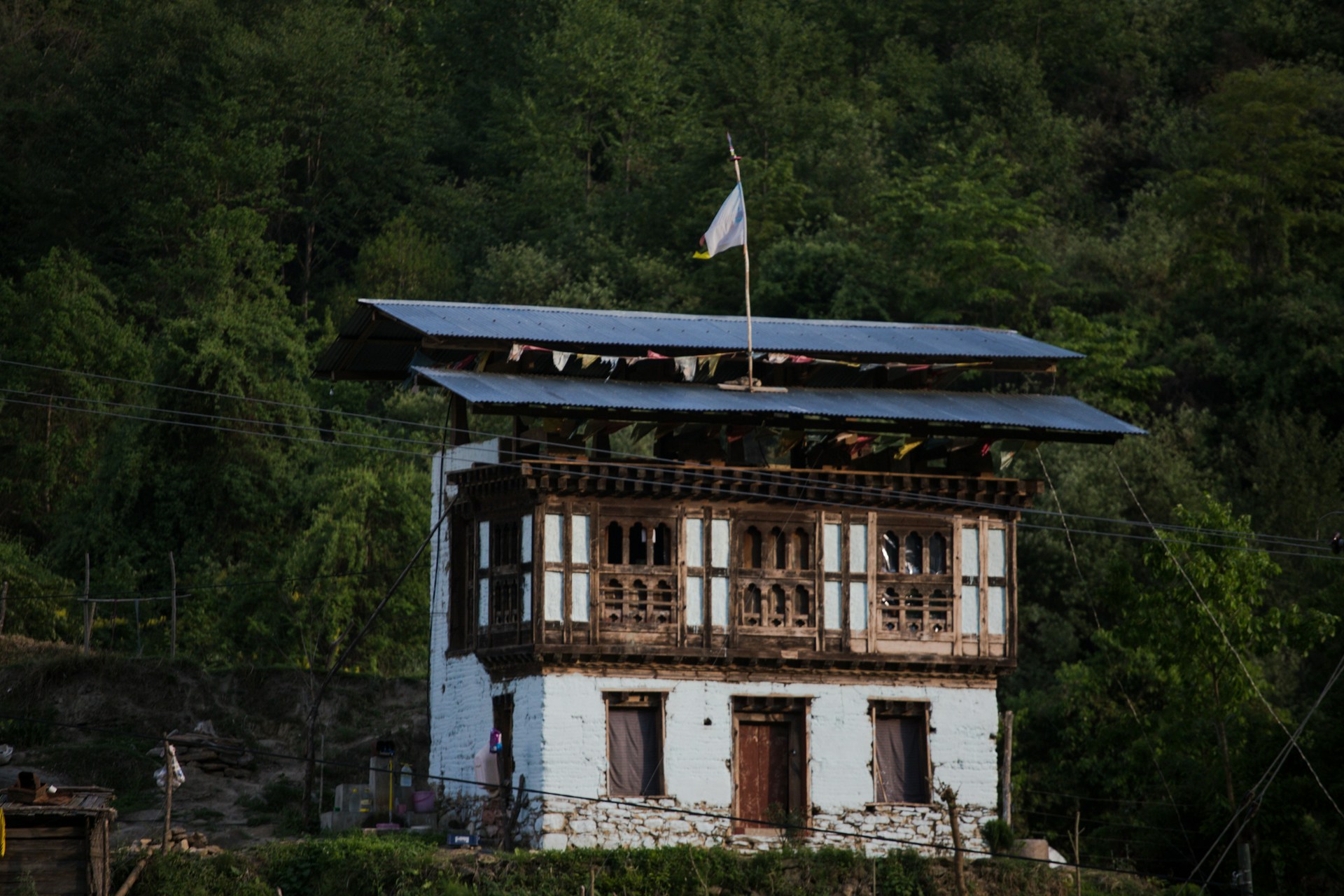
Cultural Significance of Bhutanese Farmhouses
Farmhouses are the heart of Bhutanese rural life, where families live, farm, cook, and celebrate traditions. Decorated with colorful paintings, wooden carvings, and religious symbols, they reflect Bhutan’s deep-rooted spirituality and artistic heritage. Farmhouses often contain altars for daily prayers, and the practice of hosting guests is tied to Bhutan’s value of hospitality and generosity. Participating in farm life—such as milking cows, preparing butter tea, or joining local meals—connects travelers to the daily rhythm and cultural identity of Bhutanese communities, fostering cross-cultural appreciation and understanding.
Historical Background of Farmhouses in Bhutan
Bhutanese farmhouses have evolved over centuries as multi-functional family homes, built to suit the region’s cold climate and communal lifestyle. Historically, they were constructed using locally sourced stone, mud, and wood, often without the use of nails or metal. Each structure included a ground floor for livestock, a middle floor for living, and an upper floor for drying crops or storing grains. Influenced by Tibetan design and Buddhist symbolism, many farmhouses were adorned with auspicious symbols like dragons or lotus flowers. These traditional homes represent self-sufficiency, harmony with nature, and architectural continuity.
Importance of Farmhouse Visits in Bhutan Travel
Visiting or staying in a Bhutanese farmhouse is one of the most authentic cultural experiences a traveler can have. Many Bhutan tour packages include farmhouse dinners or homestays to offer guests a deeper understanding of local life, food, and traditions. Guests may enjoy traditional hot stone baths, taste homemade Ema Datshi (chili and cheese), and engage in village activities. Unlike commercial hotels, farmhouses foster human connection and cultural exchange, making the experience deeply personal. For travelers seeking immersive, off-the-beaten-path travel in Bhutan, farmhouse visits provide warmth, simplicity, and an unforgettable glimpse into Bhutan’s living heritage.
National Memorial Chorten
The National Memorial Chorten is one of Thimphu’s most prominent religious landmarks, built in 1974 in honor of King Jigme Dorji Wangchuck, the Third King of Bhutan. This whitewashed stupa with golden spires and intricate carvings is centrally located in the capital and serves as a daily spiritual center for locals. Visitors can witness Bhutanese people walking clockwise around the chorten, spinning prayer wheels and offering prayers. Unlike other religious sites in Bhutan, this chorten is not a relic shrine, but rather a symbol of peace, compassion, and Bhutan’s evolving spiritual path in the modern era.
Cultural Significance of National Memorial Chorten
The Memorial Chorten is a hub of daily spiritual activity in Thimphu, especially for the elderly who gather for prayers and social connection. It embodies Bhutanese values of compassion, devotion, and community, aligning with the country's Vajrayana Buddhist philosophy. Its architecture and murals inside depict deities, spiritual teachings, and protective symbols, guiding practitioners toward enlightenment. The chorten plays a central role in local rituals and prayer ceremonies, reflecting Bhutan’s living faith. For both locals and visitors, it is a peaceful space for reflection, prayer, and engagement with everyday Bhutanese spirituality.
Historical Background of National Memorial Chorten
The chorten was commissioned by the Queen Mother, Ashi Phuntsho Choden, in memory of her son, the Third King, Jigme Dorji Wangchuck, known as the Father of Modern Bhutan. Although the king envisioned building a chorten to represent peace and prosperity, he passed away before it was completed. It was inaugurated in 1974 and remains one of the few stupas in Bhutan not containing human remains but instead serving as a symbolic monument to his vision and leadership. Over time, it has become a national site of prayer, unity, and historical remembrance.
Importance of Memorial Chorten in Bhutan Travel
For travelers, the National Memorial Chorten offers a unique chance to observe living Bhutanese spirituality in action. It is a highlight in most Thimphu city tours and draws interest not just for its structure, but for its atmosphere of devotion. Unlike remote temples, this chorten is highly accessible, allowing tourists to walk among locals, spin prayer wheels, and witness real-time prayer rituals. The site provides insight into Bhutanese religious life, art, and community values. As a centrally located and photo-friendly landmark, the chorten is an essential cultural stop for every Bhutan travel itinerary.
If you have any questions, need help customizing your itinerary, or want to know more about our Bhutan tour packages, please feel free to contact us at Sundar Nepal Trekking Pvt. Ltd. Our experienced travel experts are here to assist you with personalized guidance, competitive pricing, and professional service.
📞 Call/WhatsApp: +9777-9851101623
📧 Email: [email protected]
🌐 Website: www.sundarnepaltreks.com
We look forward to helping you experience the magic of Bhutan!



